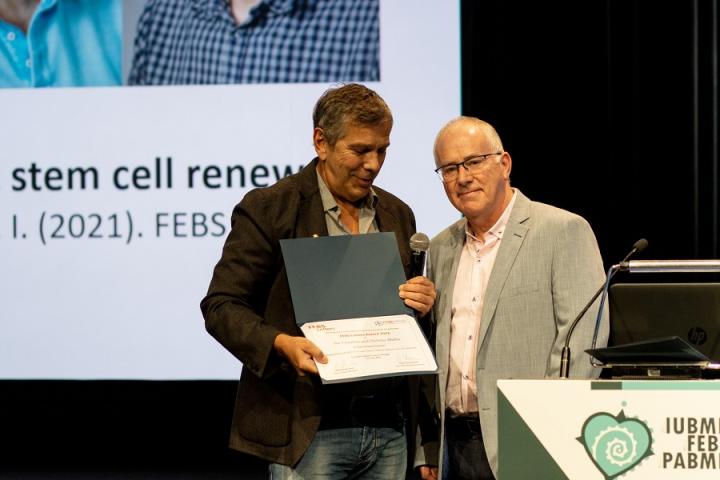FEBS Letters rewards team for outstanding paper of 2021
Head of the Institute for Stem Cell Research, Professor Ian Chambers and has been awarded the FEBS Letters Award 2022.

He received the award with Dr Nicholas Mullin for their outstanding paper 'Phosphorylation of NANOG by casein kinase I regulates embryonic stem cell renewal'.
Professor Chambers presented a plenary lecture about this work at the 46th FEBS Congress in Lisbon, Portugal, 9-14 July 2022, where he officially accepted the prize on behalf of himself and Dr Mullin
The award-winning article was selected by a special committee, formed by appointed members of the FEBS Letters Editorial Board, plus one external member.
The Award Committee was chaired by Michael Brunner, Editor in Chief of FEBS Letters.
FEBS Letters is a not-for-profit society journal for the rapid publication of research reports that “significantly impact and advance knowledge in the molecular life sciences”.
Stem Cell Self-Renewal

In the paper, the authors report a new mechanism by which NANOG regulates embryonic stem cell self-renewal in mice.
NANOG is a transcriptional regulator, which means it binds DNA and switches on and off genes that are important in stem cell self-renewal.
Self-renewal, a defining feature of stem cells, is when stem cells divide to make more stem cells to expand the population.
The team found that the enzyme casein kinase I phosphorylates NANOG and that this enhances self-renewal.
Phosphorylation Mechanism
The discovery was made by molecular mapping sites of casein kinase I phosphorylation on NANOG and focussing on novel phosphorylation sites in the DNA binding domain of NANOG.
The team mimicked phosphorylation by genetically engineering a negatively charged amino acid at the phosphorylation site and this mutant NANOG protein enhanced embryonic stem cell self-renewal.
Nanog is named after Tir nan Og the legendary “Land of the Ever-Young”. Professor Chambers and colleagues chose the name as the gene effectively makes stem cells immortal.
These novel findings indicate how phosphorylation may influence interactions with the NANOG DNA binding domain that underpin embryonic stem cell self-renewal.
This was a fun collaborative effort. It will be exciting to find out what partner proteins bind to phosphorylated NANOG to mediate enhanced self-renewal.
For our work to be recognized by FEBS letters is a great accolade and we are delighted to receive the award.
Related Links
Phosphorylation of NANOG by casein kinase I regulates embryonic stem cell renewal, FEBS Letters

